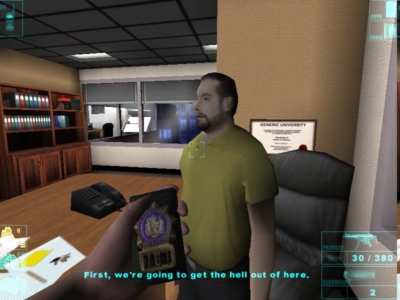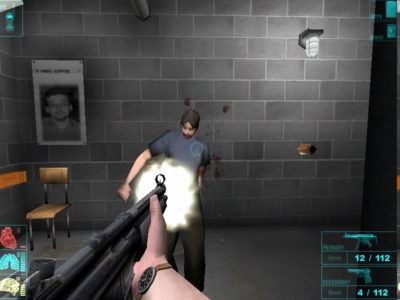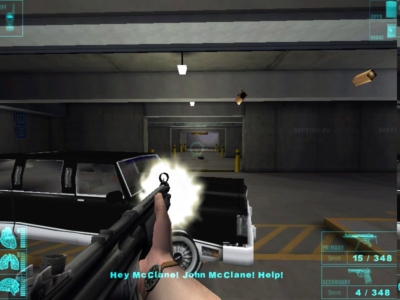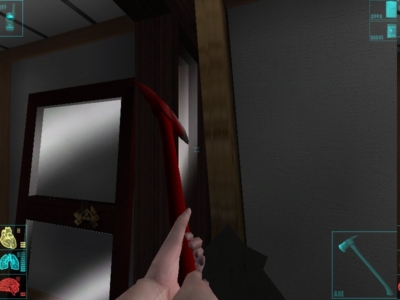
Die Hard: Nakatomi Plaza
Written by: Rik
Date posted: January 21, 2008
- Genre: Action
- Developed by: Piranha Games
- Published by: Sierra
- Year released: 2002
- Our score: 6
It should go without saying, but in any case it’s worth re-stating: Die Hard is an awesome movie. If by any chance, you haven’t seen it, you really should make it an urgent priority. It’s more fun than playing this game and it’s a damn sight more entertaining than reading this review is going to be. In fact, chances are there’s a clumsily-censored version of it on TV right now: go ahead – you have our permission.
Great films don’t always make for great games, though, and official tie-ins have traditionally been an excuse to churn out sloppy and generic titles in search of a quick buck. Ever since Atari famously had to ditch 5 million unsold copies of their E.T. game in the desert, gamers have had good reason to be wary of film licenses, especially those rush-released to coincide with a film appearing in cinemas. While we still get plenty of those, a more recent phenomenon has been to exhume old franchises and release a spin-off game many years after the film first came out. It’s certainly an interesting idea, and there does at least seem to be a bit more of an incentive for developers to get it right, but you could also argue that this is no better than your standard licensed filth – merely a way of squeezing a bit of cash out of an existing fanbase in return for minimal effort.

There are a couple of slightly lame ‘protect the hapless civilian’ missions. This chap is probably starting to regret staying late at the office.
Die Hard: Nakatomi Plaza is kind of a mixed bag. While it does have its merits, it’s certainly not going to be the answer to every fanboy’s prayers, either. So, let’s start with a disclaimer: even though in this game you are Officer John McClane, and the plot roughly follows that of the film, playing it is not going to be like starring in your very own version of Die Hard. If you imagine that you’ll be leaping across elevator shafts, experiencing a tense moment or two trying to avoid detection while crawling through air vents, or participating in thrilling boss-battle fire-fights with intelligent AI terrorists where you may choose to dive sideways through an open door in slow-motion, then you’re going to be disappointed. Because this game just isn’t like that.
Instead, what we essentially have here is a fairly standard first-person shooter that makes a reasonable effort to be faithful to the spirit of the movie without offering too much in the way of innovation. On the plus side, many of the film’s most memorable scenes are either recreated in the game itself or via an in-engine cut-scene, and it all starts extremely promisingly with baby-faced chauffeur Argyle dropping you off at the entrance of your missus’ office and you fumbling about at reception trying to find her name on the touch-screen monitor. And, once you’re thrown into the game proper, lightly armed, shoeless and trying desperately to avoid terrorist gunfire, it’s all quite entertaining.
Early levels see significant progression along the film’s storyline, and while these bits are done quite well, overall enjoyment is tempered by the presence of obvious shortcomings. Firstly, for a relatively modern game, DH:NP is pretty damn ugly to look at. Both levels and characters are on the “boxy” side, and on the whole its appearance can best be described as “rough around the edges”. You’ll also notice that by the time you’ve got through the first couple of levels, you’ll have already blown away roughly three times as many terrorists as featured in the entire Die Hard movie. Once you’ve completed the game the body count will have reached preposterous levels, and it’s safe to say that the people responsible for cleaning up the building once the whole thing is over would need a markedly bigger truck to cart away the corpses than the one the terrorists themselves supposedly used on their way in.

Three bars at the bottom left of the screen show your levels of health, stamina and, er, mental state. You should only ever need to worry about the first one.
Okay, so it’s a game, not a documentary, but it’s slightly irritating to discover that few concessions to the film have been made in this department, with the developers choosing instead to stick to the tried-and-tested ‘blow 1,000 bad guys away’ formula seen many, many times before. Even by traditional FPS standards, however, the number of terrorists you need to kill still seems slightly excessive, and while it may be stretching it a bit to call it an easy game (there are some more-than-tricky moments) the fact that you can emerge victorious when up against such odds tells you all you need to know about the intelligence of your AI foes. Generally, any struggles you may encounter are normally down to the sheer number of enemies you may be faced with at any one time. A single terrorist is disposed of easily enough, and although they do have a few evasive tactics to stop them acting as pure cannon fodder, they’re ill-equipped to deal with even the least subtle of human tactics, and running straight at them while keeping your finger on the trigger seems to do the job most of the time.
For many, this will be a make-or-break factor in determining whether they are going to enjoy the game or not. If you can accept the fact that you’re not going to be engaging occasional AI foes in taut, skilful encounters, but instead will be called upon to shoot large numbers of fairly unintelligent fake terrorists in the head, then you’ll be able to have some fun with it. If not, you’re going to be disappointed, and perhaps even a little bit angry. There are several ‘boss’ battles, where you face particularly notorious terrorists (ie the ones Bruce Willis has extended face-offs with in the film), but though there is a noticeable increase in difficulty during these sections, it’s largely down to the fact that your foes are able to endure several hundred rounds of ammunition without dying rather than anything particularly cunning on their part.
Despite this, it has to be said that DH:NP does maintain a level of tension and a sense of ‘you against all comers’ that, to an extent, recreates some of the atmosphere of the film. Though your opponents may not be all that smart, they’re pretty decent shots, and the game certainly doesn’t allow you to take much fire without dying, so while you may be doing a lot of killing yourself, there is a certain emphasis on survival, and this is often best accomplished by making use of the handily-implemented ‘lean around corners’ feature, which also adds to the excitement during firefights.
Perhaps inevitably, there are times when the game deviates from the plot of the film, primarily in order to pad things out and make the whole thing last a bit longer. Some are pretty decent, if a bit tough, and early efforts where you disarm bombs within a set time limit and protect Argyle from attack in the parking garage are particularly playable. Others, though, are frankly rubbish, and some seem to have been shoehorned in from another game entirely, featuring locations and objectives that have little relevance to the overall terrorist/hostage/LAPD situation that makes the film so intriguing. And whoever thought it was a good idea to have a couple of levels take place in almost total darkness could have put a bit more effort into working out how they’d actually play – as it is, there’s far too much stumbling about aimlessly, getting lost, bumping into scenery, and, y’know, wanting to throw your monitor out of the window in frustration. Having said that, nothing in this game should pose too many problems to anyone who’s reasonably proficient at this kind of thing, and though things are a little uninspired during the middle sections, the action soon picks up towards the end as the film plot kicks back in.
Speaking of which, some mention must be made of the various voice-acting talents employed during the game, and it’s pleasing to be able to report that the Willis-a-like manages to sound reasonably authentic throughout. He does seem to bellow most of his lines though, and while it may be an attempt to accurately recreate the temporary deafness McClane must be suffering as result of enduring hours of relentless gunfire, it’s more likely that all the actors read their lines in isolation. Baddie-in-chief Hans Gruber is also convincing enough – although he doesn’t sound all that German, he does sound a lot like Alan Rickman, which is all you can ask for really. Others not sounding particularly German include many of the terrorists, who seem to have attracted a number of sympathisers from the Scottish highlands, and some of the supporting cast are also fairly weak. One voice that is 100% authentic is that of chunky desk-jockey Sergeant Al Powell, with the original actor from the film, Reginald VelJohnson, reprising his role here.
Summing-up time now, and we may as well start by stating the obvious: it’s the Die Hard license that makes this worth a look. Were this game released as some other generic shooter, it would have very little to recommend it, and the patchy AI, ugly graphics and occasional sloppiness (did I mention that on several occasions bullets travel through windows in this game? Well – they do) aren’t particularly endearing features. Having said that, if you’re a big fan of the movie, the fact that much of the film’s subtlety and plausibility has been abandoned in favour of familiar FPS staples might well make it less likely that you’ll enjoy the game. Personally, though, I found that there was just enough Die Hard in there to make for a reasonably fun few hours. It may not be anything like as good as it could have been, but as long as you go into it with fairly low expectations, there’s some relatively undemanding fun to be had.




 Posts
Posts